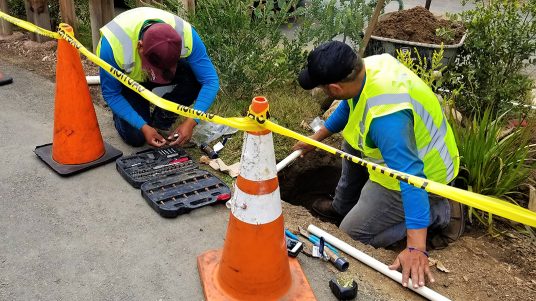What Can Be Done? Solutions for NRW
There is not a clear “one-size fits all” solution to water leakage, but there are different ways to detect, measure and repair leakages successfully. Previously we discussed the problem many utilities and communities face of Non-Revenue Water, or water that is “lost” due to leaks in infrastructure.
The Solutions can be divided into two basic stages:
• Detection of existing leaks and repair of the pipelines’ infrastructure
• Proper management and maintenance of the water distribution system, including preventative maintenance and early detection
The easiest leakage to identify is visible leakage. This will appear as clear water on the surface and if pipes are pressurized, it may well be possible to see water bubbling up to the surface.
It is possible that visible leaks have been running for some time and vegetation may indicate the presence of a leak even if there is no water on the surface. The actual location of the leak is not always at the point it comes to the surface, depending on the road surface and topography and this should be verified by the pinpointing methods below, nevertheless, all staff should be encouraged to identify possible visible leaks.
Leak detection systems can provide an alert and display other related data that help to locate the problem and assist decision-making. Pipeline leak detection systems can also enhance productivity and system reliability thanks to reduced downtime and inspection time.
An acoustic leak detection system allows utilities to optimize their system performance with automatic daily surveying for distribution leaks. It can continuously monitor the entire water distribution networks and provide a complete up-to-date graphical representation of history and statistics of every point of failure. This provides engineers and decision makers in municipal water utilities and water service providers with clear decision support information to give top service at an affordable cost. It provides information for efficient pipe replacement and optimal repair.
Utilities can lower pipeline repair costs by finding and repairing leaks before they become costly main breaks. This also reduces the risk of bacteria and viruses entering the water supply through burst pipe. By pumping and treating less water, utilities will prolong the life of their treatment and pumping facilities.
With some AMI systems, a tamper flag is sent whenever the connection between the meter and meter interface unit is opened. More specifically, a communication module takes a consumption reading each hour, at the top of the hour, and places this reading into its memory. When this reading is taken, the module can detect if there is no connectivity to the meter register; and if this occurs, the communication module marks this account as having a potential tamper and includes a “tamper flag” with its next data transmission.
Satellite imagery detection is one of the newest, most innovative technologies that takes the technology used to look for water on other planets and applies that to our planet.
After scanning specific parameters, it analyzes satellite imagery to detect leaks and non-revenue-water. The technology creates images that cover 3.500 square kilometers at once. The leaks are displayed in user-friendly GIS reports, including street locations, with great accuracy that saves significant labor associated with finding leaks with other methods.
District metering analysis to identifying NRW is done by grouping and aggregating data stored in an analytic software application. By comparing the net consumption with the metered consumption in a specific district over a set time period, a utility can identify the difference and consider that number the indication of NRW, which includes leaks.
Once the analysis is complete and the analytics application has ranked the various districts according to severity, utilities can prioritize where to look for leaks. Some software applications allow the results of the district metering analysis to be viewed graphically by comparing the graph of consumption from the district meter with the graph of the aggregated consumption of the virtual meter.
Pressure management for managing NRW is another effective tool although it does not stop it completely. However, even a small reduction in pressure can mean a significant reduction in real losses through leaks.
To effectively manage pressure, it is important to comprehensively evaluate a service area and gain an understanding of its background losses before introducing pressure control.
The reduction of pressure greatly reduces the amount of night flow when the system is quiet and all without even repairing a leak!
It is an obvious conclusion that Non-revenue water is something that can no longer be ignored.
If you would like to read more about this subject, these links below will give you great information and were used to help bring you this article:

